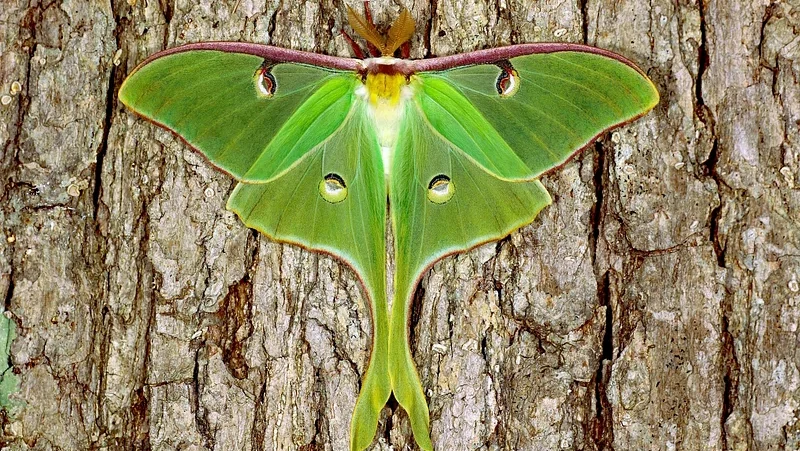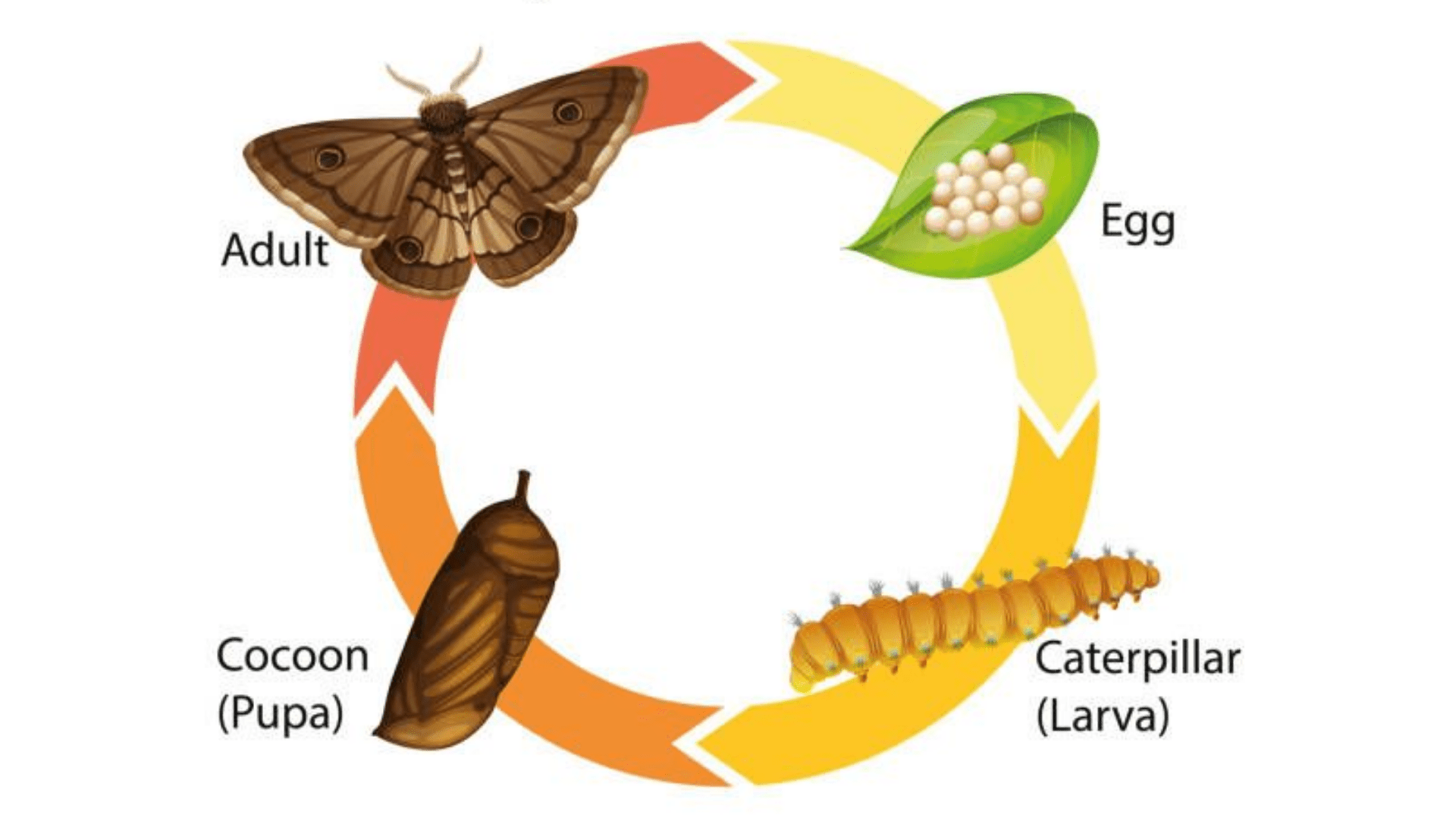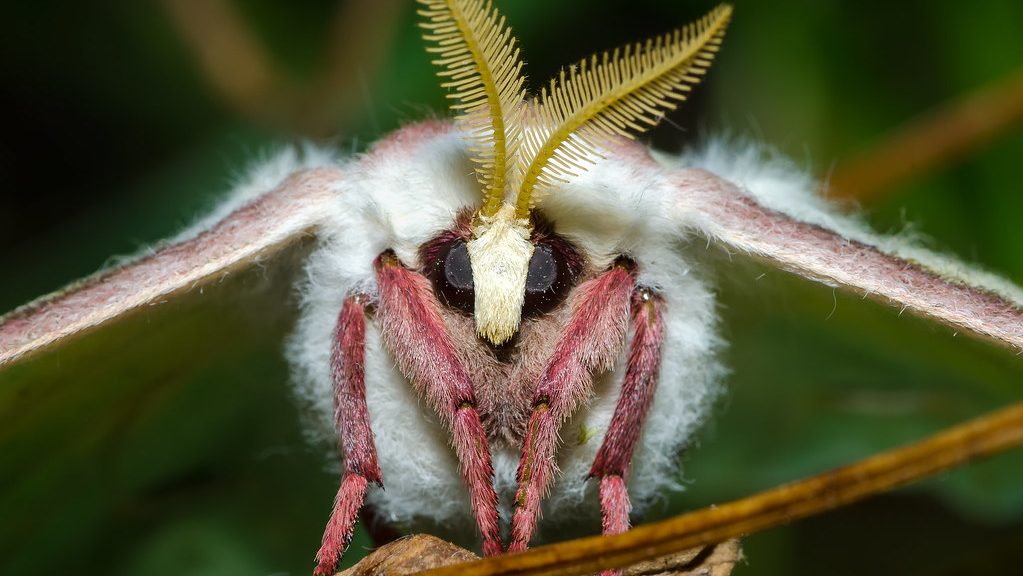Key Takeaways
-
Luna Moths' Lifespan: The adult stage lasts 7 to 10 days, during which they mate and lay eggs. The entire life cycle from egg to adult spans several months, depending on environmental conditions.
-
Life Cycle Stages: The life cycle of a luna moth includes the egg, larval, pupal, and adult stages, each designed for growth, survival, and reproduction.
-
Geographical Influence: The moth’s lifespan and emergence timing can vary based on geographic location, with southern populations potentially living longer due to warmer climates.
-
Environmental Impact: Temperature, light pollution, and humidity significantly influence the moth’s lifespan and reproductive success.
-
Defensive Adaptations: Luna moths have evolved fascinating defenses, such as camouflage and large eyespots on their wings, to protect against predators.
-
The Role of Light: Light pollution can disrupt luna moths’ natural mating behavior, shortening their lifespan and affecting reproduction.

Luna moths (Actias luna)—with their soft green wings, striking tails, and mysterious aura surrounding them—are among the most enchanting creatures of the insect world. Yet, despite their striking appearance and their cultural significance, one of the most intriguing aspects of their lives is their brief and fleeting existence. So, how long do Luna moths live? Well, the answer isn’t as simple as you might think.
While the adult stage of the luna moth’s life cycle typically lasts around one week, various stages and environmental factors influence how long these insects exist in total. In this article, we’ll dive deep into the lifecycle of luna moths, examining each stage, environmental influences, and fascinating facts along the way. By the end, you’ll not only know how long they live but also appreciate their life cycle’s complexities.
The Luna Moth Life Cycle


Not getting a solution?
Get your free pest control estimate today!Before we dive into the lifespan of the adult luna moth, it’s important to understand the full life cycle. After all, an adult luna moth is just the final chapter of a much longer and more interesting story.
1. The Egg Stage – The Beginning of It All
A female luna moth lays her eggs on the underside of host tree leaves, such as walnut, hickory, sweetgum, and birch. These eggs are relatively small but pack a big punch in terms of future potential. A single female can lay anywhere between 200 and 400 eggs, ensuring that there will be enough larvae to continue the species.
The egg-hatching process is relatively quick, occurring in about 7 to 13 days, depending on the surrounding environmental conditions, such as temperature and humidity. The egg stage marks the beginning of a fascinating transformation that will eventually lead to the magnificent moth we recognize.
2. The Larval Stage – Growing Strong
Once the eggs hatch, tiny larvae, or caterpillars, emerge. This stage is all about eating and growing. The larvae are primarily green, blending in with the leaves they feed on. They also have distinctive yellow lines and red spots that give them a unique appearance.
During the larval stage, the caterpillar undergoes five developmental stages (instars), with each stage marked by shedding its skin as it grows. This growth process lasts for about 6 to 7 weeks. During this time, the caterpillar feasts on the host plants, becoming progressively larger and more robust.
3. The Pupal Stage – Transformation Begins
Once the caterpillar has reached full maturity, it prepares for its next stage by seeking a safe place to pupate. This involves spinning a thin, single-layered silk cocoon where it will spend the next phase of its life. The pupal stage lasts about 2 to 3 weeks under normal circumstances, but in colder regions or certain environmental conditions, the moth may enter a state of diapause—essentially pausing development for several months.
This pause is influenced by environmental cues, such as temperature and light exposure, and serves to ensure the moth emerges at the right time for reproduction. The ability to remain in a state of suspended animation helps the moth survive through harsher climates or seasons.
4. The Adult Stage – The Brief and Beautiful Finale
And now, the star of the show—the adult Luna moth. This is where things get interesting. After spending weeks (or even months) developing in the cocoon, the adult emerges, soft and fragile, with wings that need to expand and harden. The expansion process can take up to 2 to 3 hours, during which the moth is particularly vulnerable to predators.
Once fully expanded, the adult moth looks nothing short of majestic. With wings that span up to 4.5 inches, they are truly a sight to behold. However, here’s the catch—adult luna moths do not feed. They have no functional mouthparts and rely entirely on the energy they store during their larval stage.
Their only purpose during this final stage is reproduction. This is where their lifespan really comes into play. Adult luna moths typically live only 7 to 10 days, during which time they mate, lay eggs, and complete their life cycle. The moth’s brief existence might seem tragic, but it’s perfectly adapted for their species’ survival. After fulfilling their role in nature’s grand scheme, the moth dies, making way for the next generation.
Factors Influencing Luna Moth Lifespan
While it’s true that the average adult luna moth only lives for about one week, several factors can influence their lifespan.
Geographic Location
Luna moths are found throughout North America, with populations in the northeastern United States, Canada, and parts of Central America. However, the time of year and the climate in which they live can greatly impact their lifespan. In cooler, northern regions, luna moths may only produce one generation per year, with adult moths appearing in late May or early June. Conversely, in warmer southern climates, luna moths may have up to two or even three generations per year.
This geographical variation influences not only how long the moths live but also when they emerge, with southern moths often having a longer adult lifespan due to warmer temperatures and fewer environmental stressors.
Environmental Conditions
Temperature, light, and humidity also play key roles in determining how long a luna moth lives. For example, extreme heat or drought can stress the moths, shortening their lifespan. On the flip side, cooler and more humid conditions tend to prolong their adult life, allowing for optimal mating and egg-laying opportunities.
Another significant factor is the rise of light pollution in urban areas. Research has shown that light pollution can interfere with moths’ natural mating patterns, causing them to either fail to reproduce or die prematurely. As nocturnal insects, luna moths rely on the moonlight to find mates. Bright artificial lighting can disrupt this natural behaviour, leading to reduced lifespan and reproductive success.

Fascinating Features and Defenses of Luna Moths
Despite their short lifespan, luna moths are equipped with some impressive adaptations that help them survive long enough to fulfil their reproductive role.
1. Camouflage and Eyespots
One of the fascinating features of luna moths is their colouration. Their green wings allow them to blend in seamlessly with the leaves on which they rest, making them difficult for predators to spot. Additionally, the large eyespots on the hindwings help ward off predators by mimicking the eyes of larger, more dangerous creatures like owls or snakes.
2. Larval Defense Mechanisms
As larvae, luna moths also have defence mechanisms to protect themselves from potential threats. If disturbed, the caterpillars can make clicking sounds by rubbing their mandibles together, which may intimidate or confuse predators, such as birds, who rely on sound to locate prey.
The Fleeting Beauty of the Luna Moth
The luna moth’s life cycle is a testament to the beauty and fragility of nature. From egg to caterpillar, to pupa, and finally, to the fleeting adult stage, each phase serves a purpose in the grand scheme of the moth’s existence. Their adult life may be short—often only lasting around one week—but it is a time spent fulfilling their role in the cycle of life, ensuring the species continues.
While their time as adults is brief, the legacy they leave behind is powerful. Their fascinating appearance, coupled with their ephemeral existence, reminds us of the transient beauty found in nature. So, the next time you spot a luna moth fluttering by, take a moment to appreciate not only its beauty but the wonder of its brief yet impactful life.
If the pest problem increases in your home – we recommend you opt for effective control strategies; we ensure your home remains moth-free. Our professionals understand the best ways to target moth infestations and other pest problems, providing long-lasting relief without compromising safety. Need an estimate for pest control? Our team is standing by, ready to help. Get A Risk Free Estimate!





